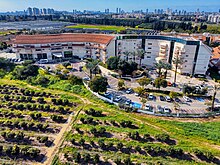
Back مساكن رعاية دائمة Arabic Betreutes Wohnen German Υποστηριζόμενη διαβίωση Greek דיור מוגן HE アシスティッド・リビング Japanese Потпомогнато живеење Macedonian Begeleid wonen Dutch Mieszkalnictwo wspomagane Polish Assisted living SIMPLE
This article needs additional citations for verification. (August 2011) |
| Disability |
|---|
|
|

An assisted living residence or assisted living facility (ALF) is a housing facility for people with disabilities or for adults who cannot or who choose not to live independently. The term is popular in the United States. Still, the setting is similar to a retirement home, in the sense that facilities provide a group living environment and typically cater to an older adult population. There is also Caribbean assisted living, which offers a similar service in a resort-like environment (somewhat like assisted vacationing).
The expansion of assisted living has been the shift from "care as service" to "care as business" in the broader health care system predicted in 1982.[1] A consumer-driven industry, assisted living offers a wide range of options, levels of care, and diversity of services (Lockhart, 2009) and is subject to state rather than federal regulatory oversight.[2] What "Assisted living" means depends on both the state and provider in question: variations in state regulatory definitions are significant and provider variables include everything from philosophy, geographic location and auspice, to organizational size and structure. Assisted living evolved from small "board and care" or "personal care" homes and offers a "social model" of care (compared to the medical model of a skilled nursing facility). The assisted living industry is a segment of the senior housing industry. Assisted living services can be delivered in stand-alone facilities or as part of a multi-level senior living community. The industry is fragmented and dominated by for-profit providers. In 2010, six of the seventy largest providers were non-profit, and none of the top twenty were non-profit (Martin, 2010). Information in this edit is from an article published in 2012 that reviewed the industry and reports results of a research study of assisted living facilities.[3]
In 2012, the U.S. Government estimated that there were 22,200 assisted living facilities in the U.S. (compared to 15,700 nursing homes) and that 713,300 people were residents of these facilities.[4] The number of assisted living facilities in the U.S. has increased dramatically since the early 2000s.
In the U.S., ALFs can be owned by for-profit companies (publicly traded companies or limited liability companies [LLCs]), non-profit organizations, or governments.[5] These facilities typically provide supervision or assistance with activities of daily living (ADLs); coordination of services by outside health care providers; and monitoring of resident activities to help to ensure their health, safety, and well-being. Assistance often includes administering or supervising medication or personal care services.
There has been controversy generated by reports of neglect, abuse, and mistreatment of residents at assisted living facilities in the U.S.
- ^ Starr, P. 1982. The Social Transformation of American Medicine. New York: Basic Books.
- ^ Anand, Geeta (2019-08-29). "Opinion | How Not to Grow Old in America". The New York Times. ISSN 0362-4331. Retrieved 2019-09-02.
- ^ Cirka, C.C., & Messikomer, C.M. 2012. Behind the facade: Aligning artifacts, values and assumptions in assisted living. Business & Professional Ethics Journal, 31 (1), 79 - 107.
- ^ CDC, Long Term Care Services, 2013, https://www.cdc.gov/nchs/data/nsltcp/long_term_care_services_2013.pdf
- ^ "Long Term Care Services" (PDF). CDC. 2013. p. 61. Retrieved August 19, 2018.